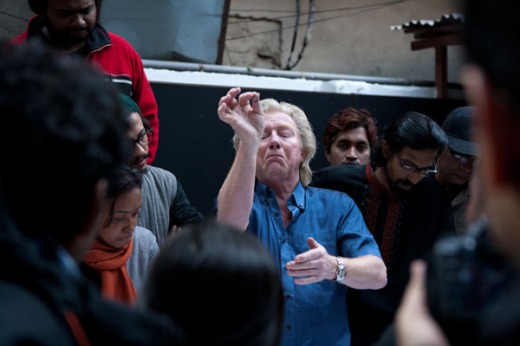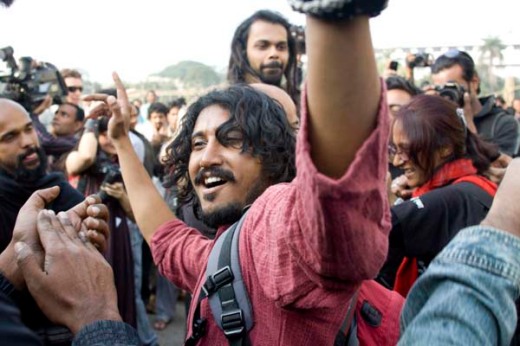The overwhelming sense of Chobi Mela VI in Dhaka, Bangladesh, in Asia at the beginning of what has been described as the Asian Century is one of potential. Huge creative potential, the potential to change the narrative of the global community, recast its mythologies and restate its essence. There are two powerful forces in the room: An historic force that has molded and inspired photographers around the world. It is a narrative art form that has its roots in the technologies and culture of print media but that lost its way in the television age. Those roots are deep and they tend to be Western. There is also a future force, a force that is economic and technological. It is a force that will only retain history’s molds and inspirations if they remain relevant in a new global multi-culture driven by fresh voices from all sectors of the world. The media that defines the future of photography is a digital internet distributed media. It is the hybrid of and tension between the past and future media that will create new work and new forms of photographic storytelling.

The warriors destroy what is tender, soft and vulnerable - the child saviour within all of us. The nurturing feminine part of ourselves is in grave danger as the creative within us struggles to survive and the five women are unable to help. From the Exhibition "Dreams" by David de Souza at Drik Gallery
The new technologies, as Drik so aptly demonstrates, is changing the audience from being secluded in a region to being global in influence. From Dhaka the stories must be different, they must be from a different perspective and in a different form. This is the Chobi Mela challenge: to emerge into the world and change it.
The context for creativity is a large part of creative energy itself. The Vietnam War created photographers who indelibly imprinted a view of the war in our minds. As Chobi Mela closes the Middle East is burning, another example of a serious shift in the dynamics of the global economy. The reaction against a narrative stolen by the West is part of a broader power shift away from the dominating economies of the West to growing economies offering individuals more say in how they are governed, more hope for how their children may live and bigger dreams of what kind of lives and identities they may have. In forty years Bangladesh has gone from famine, floods and war to an emerging creative class. It is a story of people rising. The photographers who come to show and teach here do so because they want to. They want to be seen here and they want to be part of the creative rising that comes from here. The students welcome them as teachers but the teachers are here also to learn.

Morton Krogvold the most popular teacher at Pathshala conducting a workshop on Photography Aesthetics at Pathshala. 19 January 2011. Photograph©Saikat Mojumder
The creative energy at Chobi Mela has some anger, and rightly so, there is much to be angry about. But it also has a wisdom and beauty that makes the message potentially more powerful. There is a history of non violence in this region in a world where violence has become the norm. Non violent creative expression is a powerful way to engage the world in a conversation about the future. There is power in beauty, as the student show demonstrated. As violence again breaks out in The Middle East and violence ignites the borders of India, Pakistan and Afghanistan it could be the Dhaka voice that rises for peace.

Adnan Wahid and other young photogrpahers dancing outside Goethe Institut before the opening of the Chobi Mela VI Festival. 21 January 2011. Photograph©K M Asad
Outside of Chobi Mela, Dhaka was engaged. Not only by rickshaws carrying examples of work in the show but by the energy of youth. Being part of it was fantastic. The crowds outside The Goethe Institute and the march on opening day made the city feel special. I think the young photographers who connect here, not just the Bangladeshi’s but the Nepalese, Indian and any other nationality, are potentially creating a scene in this corner of civilization, a scene with its own agenda, to bring the beauty of life to the problems of living. We are human, We are flawed. And we look to our creative people to pull it all together. I think photographers have that chance.

A film of fog masks the dangers for the son, father and uncle trio casting fish nets at dawn. One of the fishermen fell prey to a Royal Bengal Tiger five days after this picture was taken. Sundarban, Satkhira. From the exhibition "Salt Water Tears" by Munem Wasif
And so I leave Dhaka. I will return if they have me. I love good music so I need to say one last thing. The music here is amazing. The idea of an all night frenzy of spiritual music, the Baul music I heard for example, is a perfect companion to the idea of a photographic vision. I can see them fusing into a multi media whole, an energy that attracts young and old alike to a place where the vision is as warm as it is clear: we are all one.


